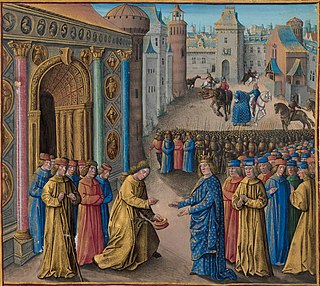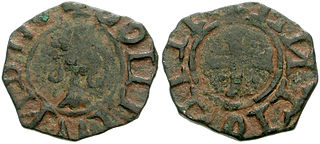Related Research Articles

Raymond of Poitiers was Prince of Antioch from 1136 to 1149. He was the younger son of William IX, Duke of Aquitaine, and his wife Philippa, Countess of Toulouse, born in the very year that his father the Duke began his infamous liaison with Dangereuse de Chatelherault.

Bohemond II was Prince of Taranto from 1111 to 1128 and Prince of Antioch from 1111/1119 to 1130. He was the son of Bohemond I, who in 1108 was forced to submit to the authority of the Byzantine Empire in the Treaty of Devol. Three years later, the infant Bohemond inherited the Principality of Taranto under the guardianship of his mother, Constance of France. The Principality of Antioch was administered by his father's nephew, Tancred, until 1111. Tancred's cousin, Roger of Salerno, managed the principality from 1111 to 1119. After Roger died in the Battle of the Field of Blood, Baldwin II of Jerusalem took over the administration of Antioch. However, he did acknowledge Bohemond's right to personally rule the principality upon reaching the age of majority.

Baldwin II, also known as Baldwin of Bourcq or Bourg, was Count of Edessa from 1100 to 1118, and King of Jerusalem from 1118 until his death. He accompanied his cousins Godfrey of Bouillon and Baldwin of Boulogne to the Holy Land during the First Crusade. He succeeded Baldwin of Boulogne as the second count of Edessa when he left the county for Jerusalem following his brother's death. He was captured at the Battle of Harran in 1104. He was held first by Sökmen of Mardin, then by Jikirmish of Mosul, and finally by Jawali Saqawa. During his captivity, Tancred, the Crusader ruler of the Principality of Antioch, and Tancred's cousin, Richard of Salerno, governed Edessa as Baldwin's regents.

The Principality of Antioch was one of the Crusader states created during the First Crusade which included parts of modern-day Turkey and Syria. The principality was much smaller than the County of Edessa or the Kingdom of Jerusalem. It extended around the northeastern edge of the Mediterranean, bordering the County of Tripoli to the south, Edessa to the east, and the Byzantine Empire or the Kingdom of Armenia to the northwest, depending on the date.

Bohemond III of Antioch, also known as Bohemond the Child or the Stammerer, was Prince of Antioch from 1163 to 1201. He was the elder son of Constance of Antioch and her first husband, Raymond of Poitiers. Bohemond ascended to the throne after the Antiochene noblemen dethroned his mother with the assistance of the lord of Armenian Cilicia, Thoros II. He fell into captivity in the Battle of Harim in 1164, but the victorious Nur ad-Din, atabeg of Aleppo released him to avoid coming into conflict with the Byzantine Empire. Bohemond went to Constantinople to pay homage to Manuel I Komnenos, who persuaded him to install a Greek Orthodox patriarch in Antioch. The Latin patriarch of Antioch, Aimery of Limoges, placed Antioch under interdict. Bohemond restored Aimery only after the Greek patriarch died during an earthquake in 1170.

Bohemond IV of Antioch, also known as Bohemond the One-Eyed, was Count of Tripoli from 1187 to 1233, and Prince of Antioch from 1201 to 1216 and from 1219 to 1233. He was the younger son of Bohemond III of Antioch. The dying Raymond III of Tripoli offered his county to Bohemond's elder brother, Raymond, but their father sent Bohemond to Tripoli in late 1187. Saladin, the Ayyubid sultan of Egypt and Syria, conquered the county, save for the capital and two fortresses, in summer 1188.
The Treaty of Devol was an agreement made in 1108 between Bohemond I of Antioch and Byzantine Emperor Alexios I Komnenos, in the wake of the First Crusade. It is named after the Byzantine fortress of Devol. Although the treaty was not immediately enforced, it was intended to make the Principality of Antioch a vassal state of the Byzantine Empire.

The Latin patriarch of Antioch was a prelate of the Latin Church created in 1098 by Bohemond I of Taranto, founder of the Principality of Antioch, one of the crusader states.

The siege of Antioch took place during the First Crusade in 1097 and 1098, on the crusaders' way to Jerusalem through Syria. Two sieges took place in succession. The first siege, by the crusaders against the city held by the Seljuk Empire, lasted from 20 October 1097 to 3 June 1098. The second siege, of the crusader-held city by a Seljuk relieving army, lasted three weeks in June 1098, leading to the Battle of Antioch in which the crusaders defeated the relieving army led by Kerbogha. The crusaders then established the Principality of Antioch, ruled by Bohemond of Taranto.

Tancred was an Italo-Norman leader of the First Crusade who later became Prince of Galilee and regent of the Principality of Antioch. Tancred came from the house of Hauteville and was the great-grandson of Norman lord Tancred of Hauteville.
John the Oxite or John Oxeites was the Greek Orthodox Patriarch of Antioch from c. 1089 until 1100, when he was exiled by Prince Bohemond I of Antioch. He fled to the Byzantine Empire and continued to govern those parts of the patriarchate that were under Byzantine rule. He was a prominent writer of religious texts, and reformer of religious and charitable foundations.

Aimery or Aymery of Limoges, also Aimericus in Latin, Aimerikos in Greek and Hemri in Armenian, was a Roman Catholic ecclesiarch in Frankish Outremer and the fourth Latin Patriarch of Antioch from c. 1140 until his death. Throughout his lengthy episcopate he was the most powerful figure in the Principality of Antioch after the princes, and often entered into conflict with them. He was also one of the most notable intellectuals to rise in the Latin East.
Ralph of Domfront was the archbishop of Mamistra and second Latin patriarch of Antioch from 1135 until 1140. William of Tyre describes him as "a military man, very magnificent and generous, a great favourite of the common people and with those of knightly birth."
Peter of Narbonne was Bishop of Albara from 1098–1100, after the Norman crusader army led by Robert of Normandy captured the city mostly inhabited by Muslims. Peter was ordained bishop as Peter I of Narbonne by John VII the Oxite, the (Greek) Eastern Orthodox Patriarch of Antioch. The appointment was made by the Patriarch because there was no Orthodox bishopric already established in Albara now populated by Christians. The new Latin bishop's elevation marked the beginning of a Latin Church resident in the East, greatly encouraged by the Crusaders to see the local Greek ecclesiastics replaced by Latin ones.
Artah was a medieval town and castle located 25 miles east-northeast of Antioch, to the east of the Iron Bridge on the Roman road from Antioch to Aleppo.

The timeline of the Kingdom of Jerusalem presents important events in the history of the Kingdom of Jerusalem—a Crusader state in modern day Israel and Jordan—in chronological order. The kingdom was established after the First Crusade in 1099. Its first ruler Godfrey of Bouillon did not take the title of king and swore fealty to the Latin Patriarch of Jerusalem, Daimbert. Godfrey's brother and successor Baldwin I was crowned the first king of Jerusalem without doing homage to the patriarch in 1100. By 1153, Baldwin I and his successors captured all towns on the Palestinian coast with the support of Pisan, Genoese and Venetian fleets and also took control of the caravan routes between Egypt and Syria. The kings regularly administered other crusader states—the Counties of Edessa and Tripoli and the Principality of Antioch—on behalf of their absent or underage rulers.
The Roman Catholic Diocese of Sidon was a bishopric in the Kingdom of Jerusalem in the 12th and 13th centuries.

The timeline of the Principality of Antioch is a chronological list of events of the history of the Principality of Antioch.
The Roman Catholic Archdiocese of Tyre was an archbishopric in the Kingdom of Jerusalem.
The diocese of Marash was an ecclesiastical jurisdiction in eastern Cilicia with its seat in the city of Marash. By the sixth century, it was an autocephalous archbishopric, but it fell into desuetude after the Arab conquest in the seventh century. The archdiocese was never revived.
References
- ↑ Asbridge 2000, p. 37.
- ↑ Barber 2012, p. 85.
- 1 2 Lock 2006, p. 23.
- ↑ Hamilton 2016, p. 7.
- ↑ Asbridge 2000, p. 34.
- 1 2 3 4 5 Hamilton 2016, p. 10.
- ↑ Hamilton 2016, p. 11.
- ↑ Asbridge 2000, p. 60.
- ↑ Lock 2006, pp. 28–29.
- 1 2 3 4 Hamilton 2016, p. 23.
- 1 2 3 4 Asbridge 2000, p. 198.
- ↑ Hamilton 2016, pp. 40, 49.
- ↑ Hamilton 2016, p. 213.
- ↑ Hamilton 2016, p. 212.
- 1 2 3 4 5 Hamilton 2016, p. 397.